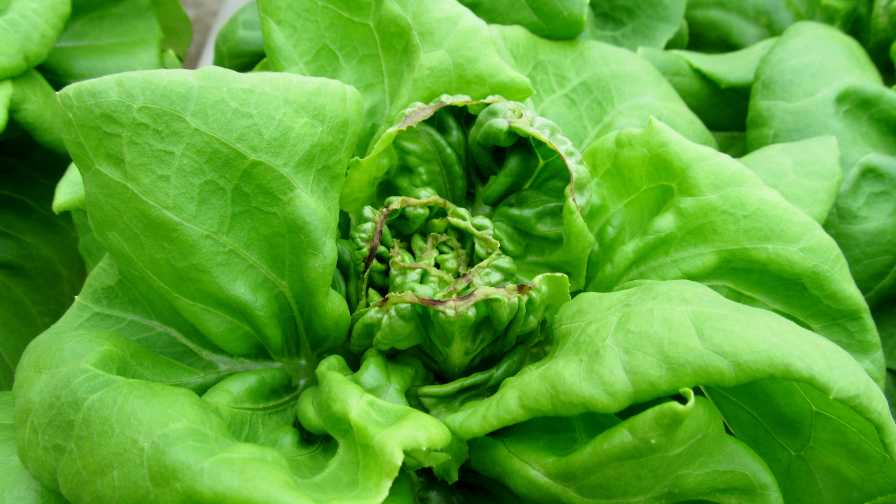Tips to Avoid Nutrient Issues in Greenhouse Lettuce

Lettuce With Tipburn. Photo: Tanya Merrill and Neil Mattson, Cornell University
Delivering a healthy plant to the consumer starts with growing a healthy crop in the greenhouse. In the case of a fresh, edible greenhouse crop like lettuce, that health becomes even more essential.
The good news, according to A.J. Both, an Extension Specialist in the Department of Environmental Sciences at Rutgers University, is that there is little excuse for plant nutrient issues in hydroponic systems as long as the grower maintains an appropriate testing scheme and provided there are no other pest or disease problems.
“It’s a little more challenging when plants are grown in any type of rooting medium (including soil), but experienced growers typically know how to prevent nutrient issues,” Both says. “While most plant nutrient recipes are very precise, many plants appear to suffer little consequences when the nutrient concentrations are kept within certain ranges. In some cases, in addition to available amounts, ratios of certain nutrients are also important.”
Proactive Steps to Avoid Problems
Of course, that doesn’t mean problems won’t develop. For example, tipburn is caused by a calcium deficiency in growing plant tissue (mostly a translocation issue) and can occur even when the nutrient solution/growing media contains sufficient calcium, Both says.
One way to prevent this, according to Daniel Wells, an Associate Professor in the Department of Horticulture at Auburn University, is to monitor air flow in the greenhouse.
“Tipburn usually affects the youngest leaves in the center of the developing head, so vertical air movement seems to be most helpful, as it is not blocked by older, exterior leaves,” Wells says.
Neil Mattson, an Associate Professor in the School of Integrative Plant Science at Cornell University, also emphasizes that periodic testing and adjustment of plant tissue is important.
“If a grower waits until a visual symptom occurs to diagnose, it is likely there is already going to be lost yield,” Mattson says. “The best approach is to have a proactive strategy of sampling the nutrient solution every one to two weeks, as well as periodically sampling plant tissue.”
Cultivar Selection is Critical
Cultivar selection is probably the most important step a grower can take to protect against tipburn, Wells advises. One of Wells’ graduate students, Sydney Holmes, recently published a research paper on the selection of heat-tolerant lettuce cultivars for better marketability. The study evaluated nine cultivars for growth, bolting, and tipburn and how they affected the attributes consumers wanted.“
Both tipburn and bolting can ruin the marketability of lettuce by causing undesirable appearance and/or taste,” Holmes notes in the paper. “Since both disorders are directly related to heat and are often responsible for marketable yield losses, resistance to either or both can be considered heat tolerance.”
Holmes’ study highlights that susceptibility to both tipburn and bolting are related to genetic diversity in lettuce. Crisphead lettuce cultivars typically have a greater genetic variation for tipburn resistance compared to Romaine and leaf types, possibly due to breeding efforts. Breeding for tipburn resistance in other lettuce types could be a successful strategy to mitigate tipburn severity in greenhouse-grown lettuce, but selective breeding has not yet produced a fully tipburn-resistant cultivar for growers.
In greenhouse applications, Holmes says, calcium foliar sprays relieved tipburn symptoms in some cases, but were not effective on tight heads (crisphead) and had limited success on other types. Production strategies that increase transpiration and reduce temperature, like blowing air across young leaves as heads start to form, have also reduced tipburn severity in some cases but are not fully effective for all lettuces.
While a combination of selective breeding and cultural practices is likely needed to fully eliminate tipburn and bolting incidences in greenhouse lettuce production, the selection of the best available cultivars offers an easily adopted production solution for growers.
Three Deficiencies to Monitor
Mattson says there are a few common disorders that might occur in some lettuce and microgreens varieties if growers aren’t periodically testing and adjusting their nutrient solution, or if their pH management is poor.
- Iron deficiency (from high nutrient solution pH; interveinal chlorosis; yellowing between the veins of the upper/young leaves): “This is often an indicator of root disease,” Mattson says. “I see this more commonly in arugula or basil than lettuce.”
- Magnesium deficiency (interveinal chlorosis of the lower/mature leaves; as symptoms progress, marginal/interveinal necrosis can also occur): “I occasionally see this in lettuce and more often see it in basil, which seems to have a high need for magnesium.”
- Nitrogen deficiency of lettuce (yellowing of lower leaves; smaller plant size): “Surprisingly, I’ve seen this show up quite a few times, especially in systems with a small nutrient solution reservoir,” Mattson says. “The EC is being managed; however, salts accumulate over time and contribute to elevated EC levels, especially if there is little available nitrogen.”










